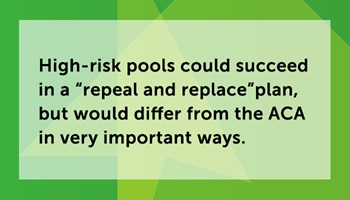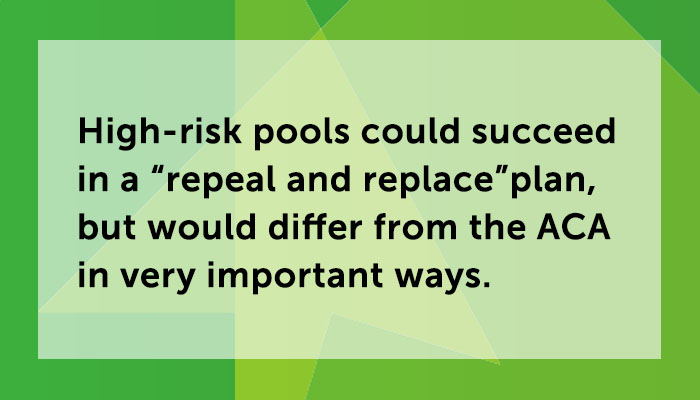This is the first in a series of posts on key U.S. health policy issues
How to insure people with past and ongoing health problems is central to the efforts of the Trump administration and Republican lawmakers to “repeal and replace” the Affordable Care Act (ACA).
The ACA guarantees people equal access to individual commercial health insurance coverage regardless of their health status. Any insurer that offers individual coverage must accept any person who applies, and cannot charge more because of that person’s health status. To stabilize premiums in a market that accepts all applicants, the ACA established a permanent state-based program of risk adjustments and requires everyone to be insured. The risk adjustment program redistributes premiums toward insurers that enroll high-risk individuals while still rewarding efficient care. The individual mandate catalyzed conservative opposition to the law.
 To replace the ACA's consumer guarantees, several emerging plans (from House Speaker Paul Ryan, Rep. Tom Price, and Sen. Rand Paul) envision a return to state high-risk pools for "uninsurable" people. Because there is no fixed definition of what makes a person uninsurable, there is no hard estimate of how many Americans fit into this category, but a recent study places the number at 27 percent of the adult population under age 65.
To replace the ACA's consumer guarantees, several emerging plans (from House Speaker Paul Ryan, Rep. Tom Price, and Sen. Rand Paul) envision a return to state high-risk pools for "uninsurable" people. Because there is no fixed definition of what makes a person uninsurable, there is no hard estimate of how many Americans fit into this category, but a recent study places the number at 27 percent of the adult population under age 65.
Before implementation of the ACA, 35 states operated high-risk pools, although only one—in Minnesota—appeared to enroll most people rejected for individual coverage. Most others had very low enrollment, despite evidence of much higher rates of people who were denied coverage because of their health status and high rates of people who were uninsured. In two states—California and Florida—the high-risk pools accepted new enrollment only sporadically or had not accepted new enrollment for many years, in effect locking the sickest people out of individual insurance.
Despite their spotty record, high-risk pools could succeed in a repeal and replace plan—that is, they could approximate the ACA’s broad protections to consumers while helping to stabilize the market for individual coverage. But they would differ from the ACA in very important ways.
Medical Underwriting
The first key difference would be a return to medical underwriting. Presumably, insurers would rehire a workforce of medical underwriters, adding a layer of administrative cost that was abandoned with implementation of the ACA. If ACA’s repeal also relieves insurers from restrictions on the premiums they can charge net of medical costs (called a medical loss ratio), insurers will pass the new cost of underwriting forward into the premiums that all individual consumers pay.
Medical underwriting means that individuals would again face the prospect of rejection for coverage because of their personal health history. Before the ACA, some states used lists of conditions (such as a heart condition, cancer, or HIV/AIDS) that would presumptively make an applicant uninsurable. In principle, these lists saved consumers the effort, cost, and delay of applying for individual coverage (paying for the first month of coverage in advance) and being rejected. However, consumers who did not have any of the listed conditions could still be rejected. Only if rejected—or, in some states, advised in writing by a broker that they were likely to be rejected—could they then qualify for coverage in the high-risk pool.
An ACA replacement proposal could minimize the complexity of this process for consumers by requiring insurers to notify the high-risk pool of any rejection and to automatically transfer that applicant to the high-risk pool. In this case, no applicants would technically be denied. But they would be resituated in alternative coverage that might or might not be like the plan they had wanted.
Who Pays?
A second key difference between guaranteed issue of individual coverage and a market with risk pools is who would pay for high-risk consumers’ health care. Because consumers who buy coverage in a high-risk pool would be isolated with other high-cost consumers, they would pay much more than they do now, and much more than people accepted in the private market, unless deeply subsidized to offset the difference.
However, high-risk pools have a poor record of adequate public funding. Historically, states with high-risk pools subsidized premiums by taxing the health insurance premiums paid by other individuals and insured groups (mostly small employers). Very few states augmented these revenues with funds from other sources. Keeping taxes on insurance premiums low meant keeping subsidies to the high-risk pools low relative to medical cost. As a result, high-risk pool premiums were high.
In an effort to make premiums more affordable, high-risk pools shifted significant costs to enrollees at the point of service. Deductibles and coinsurance were typically high. Moreover, waiting periods of up to one year for coverage of preexisting conditions were common (so that enrollees had no coverage for the conditions that caused them to be rejected for individual coverage), and annual and lifetime limits on coverage were the norm. The ACA banished all of these constraints on coverage, and new high-risk pools could operate without them as well—but not without substantial public funding to offset the loss of broad risk pooling.
Looking for Cost Savings
High-risk pools might achieve cost savings, reducing the burden on both consumers and tax payers, by paying for care that is more efficient than it had been historically. However, there are limits on how efficient a high-cost patient’s care can be. The cost of care for very sick patients will predictably exceed even very high deductibles, beyond which more care has (and arguably should have) no further financial consequences to the patient.
New high-risk pools might be more successful at curbing costs if they borrowed lessons from the payment and delivery system reforms that the ACA has encouraged for Medicare and Medicaid beneficiaries, and also are becoming the norm in large employer plans. Such reforms bundle payments for some services, connect payment to the quality of care, integrate behavioral and physical health, and introduce care management to reduce hospital readmissions and use of emergency departments—in general, seeking to encourage appropriate care and disrupt fee-for-service incentives for providers to deliver care of little or no value to the patient. However, in the individual market, patients with health problems—who are likely already to have selected providers and a care regimen—might resist moving into health plans that do not cover their providers and services.
Making a Choice
Even if high-risk pools were assembled around the payment and delivery system reforms that the ACA has encouraged, care for high-risk pool enrollees will be expensive. And in the end, financing health care is, by and large, a zero-sum game: if healthy consumers do not shoulder more than their own low costs of care—in effect, making a down payment on the days when they will become high-risk—then the highest costs of care will be paid by consumers when they are sick and most vulnerable and by taxpayers.
The ACA made one choice, enrolling high- and low-risk individuals in the same insurance market. By segmenting the market, high-risk pools will make another. Healthy consumers might pay less in an insurance market that isolates them from high-risk consumers, but the sickest consumers and taxpayers will pay more.



